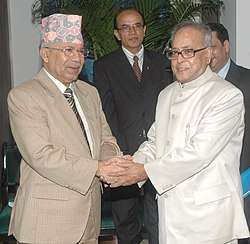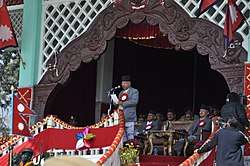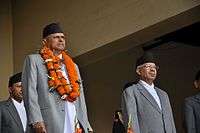Madhav Kumar Nepal
Madhav Kumar Nepal (Nepali: माधवकुमार नेपाल ![]()

Madhav Kumar Nepal | |
|---|---|
| 34th Prime Minister of Nepal | |
| In office 25 May 2009 – 6 February 2011 | |
| President | Ram Baran Yadav |
| Preceded by | Pushpa Kamal Dahal |
| Succeeded by | Jhala Nath Khanal |
| Deputy Prime Minister and Ministry of Defence of Nepal | |
| In office 30 November 1994 – 12 September 1995 | |
| Prime Minister | Man Mohan Adhikari |
| Preceded by | Girija Prasad Koirala |
| Succeeded by | Prakash Chandra Lohani |
| Minister of Foreign Affairs | |
| In office 30 November 1994 – 12 September 1995 | |
| Prime Minister | Man Mohan Adhikari |
| Preceded by | Girija Prasad Koirala |
| Succeeded by | Prakash Chandra Lohani |
| Personal details | |
| Born | 6 March 1953 Gaur, Rautahat, Nepal |
| Political party | Nepal Revolutionary Organisation (Marxist–Leninist) (Before 1975) All Nepal Communist Revolutionary Coordination Committee (Marxist–Leninist) (1975–1978) Communist Party of Nepal (Marxist–Leninist) (1978–1991) Communist Party of Nepal (UML) (1991–present) |
| Other political affiliations | United Left Front (1990–2002) |
| Alma mater | Tribhuvan University |
| Website | www.madhavnepal.com.np |
Personal life
Madhav Kumar Nepal was born into Brahmin family[4] to Mangal Kumar Upadhyaya and Durgadevi Upadhaya.[1] He graduated in Commerce from Tribhuvan University in 1973 and worked in banking and civil service before turning to full-time politics. He has two brothers, Binod Kumar Upadhyaya and Saroj Kumar Upadhyaya and three sisters, Kalika Bhandari, Indira Neupane and Basudha Pokharel.

He is married to Gayatri Acharya. He has a son and a daughter, Saurav and Suman Nepal.
Political responsibility
- 2056 B.S : House of Representatives, Rautahat area no. 1 and 2
- 2056 B.S : Leader of the opposition, the House of Representatives
- 2051-2052 BS: Deputy Prime Minister and Minister of Defense and Foreign Affairs
- 2048-2055 : Leader of opposition parties, National Assembly
- 2047 : Member, Constitution Suggestion Commission
Political activism
Nepal joined the communist movement in 1969. In the underground struggle, he used party names such as 'Subodh', 'Sunil', 'Ranjan' and 'Bibek'. In 1971 he became a district committee member of the Nepal Revolutionary Organisation (Marxist-Leninist). At a conference held in Biratnagar June 7–8, 1975, M.K. Nepal was elected as a bureau member of the All Nepal Communist Revolutionary Coordination Committee (Marxist-Leninist). When the ANCRCC(ML) founded the Communist Party of Nepal (Marxist-Leninist) in 1978, M.K. Nepal was elected a politburo member of the new party.

Statesman
He was the Deputy Prime Minister in the Nepalese government during the CPN(UML) minority government in 1994-1995 as well as the leader of the opposition in the National Assembly during the 1990s. He argued for the Nepal Civil War to be solved through talks and did not believe that mobilization of the army was the solution and as the leader of CPN UML, was one of the three key Nepali leaders, the other two being Prime Minister Girija Prasad Koirala and Maoist Rebel leader Pushpa Kamal Dahal 'Prachanda', crucial in bringing the Maoists into the peace process and signing the 12 point peace accords that ended the decade long Nepal Civil war.

Nepal was arrested in 2001 during a crackdown on anti-government protest. Following the palace massacre he called for Prime Minister Girija Prasad Koirala to step down, though later joined forces with him to launch a campaign against King Gyanendra's assumption of executive powers.
On 12 April 2008, Nepal resigned as General Secretary of the CPN (UML),[5] after having lost the Kathmandu-2 seat to Maoist candidate Jhakku Prasad Subedi in the 2008 Constituent Assembly election.[6] Subedi was a comparatively obscure candidate.[7] Nepal was also defeated in Rautahat-6 constituency by CPN(M) candidate Devendra Patel.[8] He later won both the seats in the second Constituent Assembly election in 2013, defeating his opponent in Kathmandu -2, Nepali Congress candidate Deepak Kuikel by a margin of over 10,000 votes. He defeated the same opponent in Kathmandu-2, again in the 2017 Nepal General Election by a margin of 14000 votes, earning nearly twice the number of votes as his opponent, Deepak Kuikel.
In June 2008, the CPN (UML) proposed that M. K. Nepal become the country's first President, following the declaration of a republic.[9]
In the 2017 General election under the newly written constitution, he is contesting from Kathmandu-2 only because the new constitution no longer allows candidates to be candidates from multiple constituencies. He is running against Nepali Congress candidate Deepak Kuikel and Bibeksheel Sajha Party candidate Suryaraj Sharma.
Prime minister

He became Prime Minister of Nepal on 25 May 2009 after his predecessor Prachanda resigned over a conflict with the president over the dismissal of the army's chief of staff.[10]
Prime Minister Nepal resigned on June 30, 2010 in an effort to help the government move past its deadlock and to pave the way for a national consensus government, as demanded by the opposition.[11]
References
- K.C., Surendra. Aitihasik dastavej sangroh - bhag 2. Kathmandu: Pairavi Prakashan, 2063 B.S. p 460.
- "Nepal parliament elects new PM".
- "Nepal PM quits in live TV address". BBC News. June 30, 2010.
- "CPN-UML Comrades Apart". Spotlight Nepal Magazine. Retrieved 2017-12-13.
- "MK Nepal announces resignation as UML gen secy", Nepalnews, April 12, 2008.
- "UML gen secy loses to CPN-M candidate in Kathmandu-2; NWPP takes both constituencies in Bhaktapur" Archived 2008-11-22 at the Wayback Machine, Nepalnews, April 12, 2008.
- "Big Maoist wins could reshape Nepal's politics", The Christian Science Monitor, April 15, 2008.
- "MK Nepal loses in Rautahat, too", Nepalnews, April 14, 2008.
- "UML, Maoist leaders differ on presidential candidate", Nepalnews, June 21, 2008.
- "Communist leader elected Nepal PM". BBC. 23 May 2009.
- "Prime Minister Madhav Kumar Nepal Resigns". Nepal News. 1 July 2010.
Further reading
- Busky, Donald F (2002). Communism in History and Theory. Praeger/Greenwood. ISBN 0-275-97733-1
- Hutt, Michael (2004). Himalayan "People's War". C. Hurst & Co Publishers. ISBN 1-85065-722-X
External links
| Wikimedia Commons has media related to Madhav Kumar Nepal. |
| Party political offices | ||
|---|---|---|
| Preceded by Madan Kumar Bhandari |
Chairman of the Communist Party of Nepal (Unified Marxist-Leninist) 1993–2008 |
Succeeded by Jhala Nath Khanal |
| Political offices | ||
| Preceded by Pushpa Kamal Dahal |
Prime Minister of Nepal 2009–2011 |
Succeeded by Jhala Nath Khanal |
